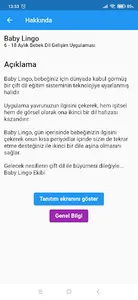Baby Lingo is a technology-adapted version of a world-accepted bilingual education system for your baby.
The application attracts your pup's attention and gives him a second language memory both auditory and visually.
Baby Lingo attracts your baby's attention during the day and makes him familiar with a second language in short periods with your repetition support.
In this article, we try to answer a frequently asked question: If a baby starts learning two languages, will his/her mental development be negatively affected? If two languages are learned at the same time, will language development be delayed? We get the answers to these questions from speech therapy specialist Özlem Akgün Bilgili.
Bilingualism and Second Language Teaching in Preschool Period
Ömer was 3.5 years old, an active child. However, as the days went by, he started to become irritable and throwing tantrums. Her mother started the kindergarten thinking that she was bored at home alone, but this time complaints started because she hit the children there. Ömer had just begun to speak and what he was saying could not be understood. His mother gave birth to Ömer in England, and they returned to Turkey when he was two years old. She was trying to speak both English and Turkish with Ömer because her mother wanted her to learn English at an early age. He also attended English classes at home. However, Ömer was unable to express himself in both languages.
It seems that Ömer was experiencing the difficulties of growing up in a bilingual environment. In general, children do not have much trouble acquiring two languages at the same time. However, the way these languages are presented, individual and environmental factors are very important!
Language is inextricably intertwined with all our mental processes. Thinking, remembering, grasping, directing attention, perceiving etc. There is language in all mental activities. Language and mind develop parallel to each other. For this reason, the child's language development supports his entire mental development. When babies are born, they have the potential to acquire the language spoken in the environment they were born into. While babies all over the world have the ability to make all sounds from the moment they are born, as time passes, they only repeat the sounds in the language spoken around them. At this point, babies exposed to different language inputs begin to acquire different languages.
“Bilingualism” means the ability to communicate in two different languages. Children who grow up in an environment where two different languages are spoken from the moment they are born can acquire both languages naturally.
Such situations are defined as “multilingualism”. “Monolingualism”, on the other hand, refers to the ability of children who grew up in environments where only one language is spoken, to communicate in that language.
Researchers argue that brain development is very important, especially in the first three years, and language acquisition is easier for the child during this period. A two-year-old child has more synaptic connections in his brain than an adult. These synaptic connections in the brain are lost when not used. For this reason, it is emphasized that it is more advantageous to teach two different languages to the child in the early period.
The application attracts your pup's attention and gives him a second language memory both auditory and visually.
Baby Lingo attracts your baby's attention during the day and makes him familiar with a second language in short periods with your repetition support.
In this article, we try to answer a frequently asked question: If a baby starts learning two languages, will his/her mental development be negatively affected? If two languages are learned at the same time, will language development be delayed? We get the answers to these questions from speech therapy specialist Özlem Akgün Bilgili.
Bilingualism and Second Language Teaching in Preschool Period
Ömer was 3.5 years old, an active child. However, as the days went by, he started to become irritable and throwing tantrums. Her mother started the kindergarten thinking that she was bored at home alone, but this time complaints started because she hit the children there. Ömer had just begun to speak and what he was saying could not be understood. His mother gave birth to Ömer in England, and they returned to Turkey when he was two years old. She was trying to speak both English and Turkish with Ömer because her mother wanted her to learn English at an early age. He also attended English classes at home. However, Ömer was unable to express himself in both languages.
It seems that Ömer was experiencing the difficulties of growing up in a bilingual environment. In general, children do not have much trouble acquiring two languages at the same time. However, the way these languages are presented, individual and environmental factors are very important!
Language is inextricably intertwined with all our mental processes. Thinking, remembering, grasping, directing attention, perceiving etc. There is language in all mental activities. Language and mind develop parallel to each other. For this reason, the child's language development supports his entire mental development. When babies are born, they have the potential to acquire the language spoken in the environment they were born into. While babies all over the world have the ability to make all sounds from the moment they are born, as time passes, they only repeat the sounds in the language spoken around them. At this point, babies exposed to different language inputs begin to acquire different languages.
“Bilingualism” means the ability to communicate in two different languages. Children who grow up in an environment where two different languages are spoken from the moment they are born can acquire both languages naturally.
Such situations are defined as “multilingualism”. “Monolingualism”, on the other hand, refers to the ability of children who grew up in environments where only one language is spoken, to communicate in that language.
Researchers argue that brain development is very important, especially in the first three years, and language acquisition is easier for the child during this period. A two-year-old child has more synaptic connections in his brain than an adult. These synaptic connections in the brain are lost when not used. For this reason, it is emphasized that it is more advantageous to teach two different languages to the child in the early period.
Show More







